We love science at St James’!
Our science journey begins in Nursery and Reception where we spend our days exploring the world around us. Our teachers provide us with a huge range of scientific opportunities both indoor and out, encouraging us to handle, explore, comment and ask questions about what we observe in our natural world (such as plants, animals and natural objects), and we spend a lot of time discussing why things happen and how things work while we are building, making and playing. We also look closely at similarities, differences, patterns and changes.
This is done by going on nature walks and collecting objects; making rubbings from trees or stones; exploring solids and liquids through cooking; growing a plant from seed; looking closely through magnifying glasses and taking photos; and recording what we find through drawing, writing and making models. All of this lays an excellent foundation to develop inquisitive scientists!








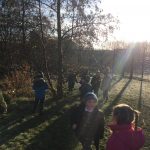

Once we are in Year 1 we begin following the National Curriculum for Science. All of our science learning is a combination of the knowledge and understanding of biology, chemistry and physics content, alongside the development of our practical skills in working scientifically through experiencing a range of scientific enquiry, all designed to develop curiosity and excitement.
Our science lessons are fun!
Lessons are always as practical as possible, encouraging us to investigate for ourselves, be curious, and discover answers to our own questions. In Key Stage One the curriculum focusses on first-hand practical experiences.
We learn about how to identify and grow plants, investigating what a plant needs to grow; naming the parts of the body and investigating the associated senses, and learn about growing up and keeping healthy; identifying and naming birds, mammals, fish, reptiles and amphibians, as well as herbivores, omnivores and carnivores, and look at habitats and food chains; comparing the properties of everyday materials; and observing changes across the four seasons.
This is all done through observing closely, observing changes over a period of time, noticing patterns and relationships, grouping and classifying, carrying out simple comparative tests, and finding things out using secondary sources of information such as books, photographs and videos. We also work across the curriculum, using our mathematical skills to collect, present and analyse data, our teamwork skills to work collaboratively, and our literacy skills to communicate our findings both verbally and written.
Some examples of us working scientifically in Key Stage One are our fantastic taste tests, blindfolded obstacle courses and feely bags to investigate senses; investigating the best material to make an umbrella for Teddy; using glitter to observe germs and hygiene; going on nature walks to spot signs of the seasons; and growing our own beanstalk like Jack and the Beanstalk!






As we move into Key Stage Two we build on our biology, chemistry and physics knowledge, and further develop our skills in working scientifically. We ask more of our own questions to broaden our scientific view of the world around us, and we begin to make decisions about the best types of scientific enquiry and equipment needed to answer them. We begin to make predictions, draw simple conclusions and use more detailed scientific language to talk about what we have found out, as well as suggesting improvements and raising further questions.
We learn about the functions of the different parts of a flowering plant and their life cycle, as well as grouping and classifying plants and animals and investigating their habitats; the role of skeletons, muscles, the digestive system and teeth in humans and other animals, and producers, predators and prey in food chains; to compare, group and describe rocks and fossils; about light, reflection and shadows; how magnets repel and attract, and their effect on different materials; the differences between solids, liquids and gases and the role of evaporation and condensation in the water cycle; how sounds are made and the role of vibrations in this; how to construct simple electrical circuits and investigate conductors and insulators.
This is all done through a practical approach. We set up simple practical enquiries, comparative and fair tests; make systematic and careful observations and take accurate measurements using a range of equipment; we gather, record, classify and present data in a variety of ways; we record findings using simple scientific language, drawings, labelled diagrams, keys, bar charts, and tables. Just as in Key Stage One this requires a range of skills from across the curriculum.
Some examples of us working scientifically are designing the best reflective surface for a new coat and the best material to make a curtain out of; investigating which materials are magnetic; testing rock hardness and identifying limestone; investigating the effect of friction on car speeds, and designing and making musical instruments with different pitches and volumes.


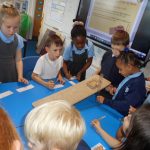
As we enter Upper Key Stage Two we develop a deeper understanding of scientific ideas, and become more systematic in our approach to exploring and talking, asking and answering questions, and drawing conclusions based on our data, observations and evidence, as well as understanding that scientific ideas develop and change over time.
We learn about the life cycles of different types of animals, their reproduction, as well as the classification system based on characteristics; the changes that occur as humans grow old, including the impact of diet, exercise, drugs and lifestyle, and the role of the circulatory system; evolution and inheritance, including adaptation; the properties of everyday materials, how mixtures might be separated and reversible and irreversible changes; the sun, the Earth, the planets and the moon, and the explanation of day and night; the forces of gravity, air resistance, water resistance and friction; how light travels in straight lines from a source, to an object and then our eyes; investigating different components and voltage in electrical circuits and represent circuits through symbols in a diagram; and the significance of the work of eminent scientists.
This is all done through planning different types of scientific enquiries to answer questions, recognising and controlling variables where necessary. We use increasing accuracy and precision to take measurements using a range of scientific equipment, and record data and results of increasing complexity using scientific diagrams and labels, classification keys, tables, scatter graphs, bar and line graphs. We use test results to make predictions to set up further comparative and fair tests, and report and present findings in a variety of ways.
Some examples of us working scientifically are researching why we have day and night and observing the inheritance traits of being able to roll our tongue – demonstrating prediction, data recording and presentation, and conclusion skills.
By now we have the foundations of excellent scientists and are ready and excited to continue our learning at Secondary School!
Recycling Wow Day
On Monday 10th March 2020 we had a Recycling Wow Day in school. This was a practical and fun cross-curricular day designed to allow everyone to work collaboratively on an extremely important science theme. We began the day with a whole school assembly on the importance or reducing, reusing and recycling, and the impact of rubbish that is not properly disposed of entering our waterways. This was run by Zoe from Plogolution –an organisation that arranges events to pick up litter whilst running and jogging!
Throughout the day half of the children got the chance to go out into the local community and Plog with Zoe and their teachers, and then sort the collected waste in order to highlight how much could have been potentially recycled. We were amazed and shocked by how much we saw and collected – the final totals were 3 bags for landfill, 25 glass bottles, 192 plastic bottles and 215 cans!
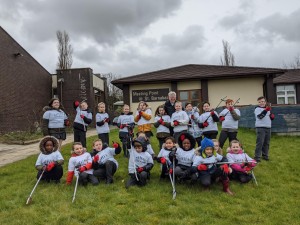

The other half of us were due to visit the local Longley Lane Recycling Centre to learn how to correctly sort our rubbish and tour the Materials Recovery Facility to see how it is sorted for recycling. This was unfortunately cancelled due to Coronavirus restrictions, but we rallied together and created our own sorting facility in the school hall learning about the science behind the MRF by watching a video and using Miss Chapman’s sieve, hammer, torches and magnets!
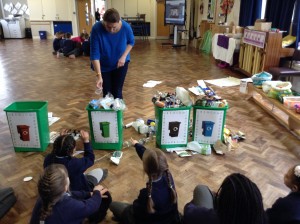
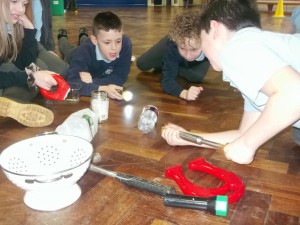


At lunch time we all sorted our waste into the correct recycling bins, and throughout the day classes took part in a range of art and DT activities to reuse waste they had collected from home. This included watching a documentary about plastic in the oceans, making newspaper fashion, making hearts out of old magazines, making animals and pots out of old bottles, making sun-catchers out of old CDs and flower cards out of old bottle tops. After many weeks of collecting plastic bottle lids we also all added a lid to the whole school mosaic, proudly on show in the entrance hall!
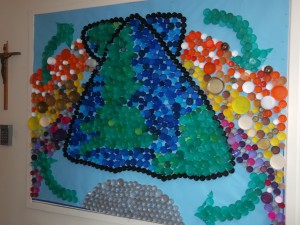

It was a fantastic day of Science, Geography, Art and DT, and everyone learnt something about how they can help improve our world – including the teachers! We finished the project by sharing our learning with our families in our weekly Good News assembly, hopefully increasing the rates of reducing, reusing and recycling across the community. You can view the assembly slides here:
Recycling Wow Day Family Assembly Slides
